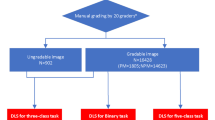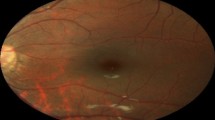Abstract
Pathologic myopia (PM) is the critical factor of irreversible visual artifacts and puts patients at risk of other severe retinal diseases such as glaucoma. Early intervention can help control the disease's progression and prevent vision loss. Due to its prevalence worldwide, automated detection of PM and its severity is essential. Deep learning-aided diagnosis has proven itself in the field of ophthalmology. The proposed study automatically classifies pathologic and non-pathologic myopia from the fundus images using a guided mini U-Net (GM-U-Net) for feature extraction integrated with a customized convolutional neural network (PMNet) explicitly designed for fundus images. The proposed GM-U-Net allows a deeper network with significantly reduced parameters than conventional U-Net for feature extraction. The proposed PMNet utilizes the features extracted by GM-U-Net to discriminate between PM and a normal retina image. The PMNet classification performance is compared with the other transfer learning models based on the features provided by the GM-U-Net. The combination of GM-U-Net and PMNet outperforms the different models for PM classification. In-depth ablation tests are conducted to realize the current form of PMNet and test its effectiveness. PMNet achieves an accuracy of 90%, average sensitivity of 93%, and specificity of 97% for binary class on the test set, demonstrating it as a valuable tool for early PM detection. Further, to localize the prominent regions in the images, colored heatmap techniques are applied to visualize the affected areas with a hotter color.













Similar content being viewed by others
Explore related subjects
Discover the latest articles, news and stories from top researchers in related subjects.References
Ohno-Matsui K, Lai TY, Lai CC, Cheung CMG (2016) Updates of pathologic myopia. Prog Retin Eye Res 52:156–187. https://doi.org/10.1016/j.preteyeres.2015.12.001
You QS, Xu L, Yang H, Wang YX, Jonas JB (2011) Five-year incidence of visual impairment and blindness in adult Chinese: the Beijing Eye Study. Ophthalmology 118(6):1069–1075. https://doi.org/10.1016/j.ophtha.2010.09.032
Yamada M, Hiratsuka Y, Roberts CB, Pezzullo ML, Yates K, Takano S, Taylor HR (2010) Prevalence of visual impairment in the adult Japanese population by cause and severity and future projections. Ophthal Epidemiol 17(1):50–57. https://doi.org/10.3109/09286580903450346
Grossniklaus HE, Green WR (1992) Pathologic findings in pathologic myopia. Retina 12(2):127–133
Zhang Z, Cheng J, Liu J, Sheri YCM, Kong CC, Mei SS (2012) Pathological myopia detection from selective fundus image features. In: 2012 7th IEEE conference on industrial electronics and applications (ICIEA) (pp. 1742–1745). IEEE. https://doi.org/10.1109/ICIEA.2012.6361007
Zhang Z, Xu Y, Liu J, Wong DWK, Kwoh CK, Saw SM, Wong TY (2013) Automatic diagnosis of pathological myopia from heterogeneous biomedical data. PLoS ONE 8(6):e65736. https://doi.org/10.1371/journal.pone.0065736
Chollet F (2017).Xception deep learning with depthwise separable convolutions, https://arxiv.org/abs/1610.02357
Devda J, Eswari R (2019) Pathological myopia image analysis using deep learning. Proc Comput Sci 165:239–244. https://doi.org/10.1016/j.procs.2020.01.084
Li J, Wang LL, Gao Y, Liang QQ, Chen LZ, Sun XL, Yang HQ, Zhao ZF, Meng LN, Xue SY, Du Q, Zhang ZC, Lv CF, Xu HF, Guo Z, Xie GT, Xie LX (2022) Automated detection of myopic maculopathy from color fundus photographs using deep convolutional neural networks. Eye Vis 9(1):13. https://doi.org/10.1186/s40662-022-00285-3
Tang JA, Yuan MZ, Tian KB et al (2022) An artificial-intelligence–based automated grading and lesions segmentation system for myopic maculopathy based on color fundus photographs. Trans Vis Sci Tech 11(6):16. https://doi.org/10.1167/tvst.11.6.16
Cui J, Zhang X, Xiong F, Chen CL (2021) Pathological myopia image recognition strategy based on data augmentation and model fusion. J Healthcare Eng. https://doi.org/10.1155/2021/5549779
Du R, Xie SQ, Fang YX, Igarashi-Yokoi T, Moriyama M, OgataS TT, Kamatani T, Yamamoto S, Cheng CY, Saw SM, Ting D, Wong TY, Ohno-Matsui K (2021) Deep learning approach for automated detection of myopic maculopathy and pathologic myopia in fundus images. Ophthalmol Retina 5(12):1235–1244. https://doi.org/10.1016/j.oret.2021.02.006
Tan TN, Anees A, Chen C et al (2021) Retinal photograph-based deep learning algorithms for myopia and a blockchain platform to facilitate artificial intelligence medical research: a retrospective multicohort study. Lancet Digit Health 3(5):e317–e329. https://doi.org/10.1016/S2589-7500(21)00055-8
Lu L, Ren P, Tang X, Yang M, Yuan M, Yu W, Han W (2021) AI-model for identifying pathologic myopia based on deep learning algorithms of myopic maculopathy classification and “plus” lesion detection in fundus images. Front Cell Dev Biol 9:719262. https://doi.org/10.3389/fcell.2021.719262
Wu Z, Cai W, Xie H, Chen S, Wang Y, Lei B, Lu L (2022) Predicting optical coherence tomography-derived high myopia grades from fundus photographs using deep learning. Front Med 9:842680. https://doi.org/10.3389/fmed.2022.842680
Parihar AS, Singh K, Rohilla H, Asnani G, Kour H (2020) A comprehensive analysis of fusion-based image enhancement techniques. In: 2020 4th international conference on intelligent computing and control systems (ICICCS) (pp. 823–828). IEEE. https://doi.org/10.1109/ICICCS48265.2020.9120999
Maheshwari A, Gupta Y (2018) Empirical aspect of big data to enhance medical images using HIPI. In: 2018 Second international conference on intelligent computing and control systems (ICICCS) (pp. 215–220). IEEE. https://doi.org/10.1109/ICCONS.2018.8663053
Zhou E, Yu W, Chen B, Ren P, Lu Q, Han W (2021) Development of deep learning-based detecting systems for pathologic myopia using retinal fundus images. Commun Biol 4(1):1225. https://doi.org/10.1038/s42003-021-02758-y
Balyen L, Tunde P (2019) Promising artificial intelligence-machine learning-deep learning algorithms in ophthalmology. Asia-Pac J Ophthalmol 8(3):264–272. https://doi.org/10.22608/APO.2018479
Zago GT, Andreão RV, Dorizzi B, Salles EO (2020) Diabetic retinopathy detection using red lesion localization and convolutional neural networks. Comput Biol Med 116:103537. https://doi.org/10.1016/j.compbiomed.2019.103537
Zhang J, Zou H (2024) Insights into artificial intelligence in myopia management: from a data perspective. Graefe’s Arch Clin Exp Ophthalmol 262(1):3–17. https://doi.org/10.1007/s00417-023-06101-5
Tan NM, Liu J, Wong DWK, Lim JH, Zhang Z, Lu S, Li H, Saw SM, Tong L, Wong TY (2009) Automatic detection of pathological myopia using variational level set. Annu Int Conf IEEE Eng Med Biol Soc 2009(2009):3609–3612. https://doi.org/10.1109/IEMBS.2009.5333517
Liu J, Wong DW, Lim JH, Tan NM, Zhang Z, Li H, Wong TY (2010) Detection of pathological myopia by PAMELA with texture-based features through an SVM approach. J Healthcare Eng 1:1–11. https://doi.org/10.1260/2040-2295.1.1.1
Ronneberger O, Fischer P, Brox T (2015). U-net: convolutional networks for biomedical image segmentation. In: International conference on medical image computing and computer-assisted intervention, Springer, Cham.http://lmb.informatik.uni-freiburg.de/people/ronneber/u-net
Du R, Ohno-Matsui K (2022) Novel uses and challenges of artificial intelligence in diagnosing and managing eyes with high myopia and pathologic myopia. Diagnostics 12(5):1210. https://doi.org/10.3390/diagnostics12051210
Zhang Y, Li Y, Liu J, Wang J, Li H, Zhang J, Xiaobing Y (2023) Performances of artificial intelligence in detecting pathologic myopia: a systematic review and meta-analysis. Eye. https://doi.org/10.1038/s41433-023-02551-7
Singh LK, Khanna M, Garg H, Singh R (2024) Emperor penguin optimization algorithm-and bacterial foraging optimization algorithm-based novel feature selection approach for glaucoma classification from fundus images. Soft Comput 28(3):2431–2467. https://doi.org/10.1007/s00500-023-08449-6
Shyamalee T, Meedeniya D (2022) Attention U-Net for glaucoma identification using fundus image segmentation. Int Conf Decis Aid Sci Appl. https://doi.org/10.1109/DASA54658.2022.9765303
Shyamalee T, Meedeniya D (2022) Glaucoma detection with retinal fundus images using segmentation and classification. Mach Intell Res. https://doi.org/10.1007/s11633-022-1354-z
Zahangir AM et al (2019) Recurrent residual U-Net for medical image segmentation. J Med Imag 6(1):014006–014006. https://doi.org/10.1117/1.JMI.6.1.014006
Zhang S, Zheng R, Luo Y, Wang X, Mao J, Roberts CJ, Sun M (2019) Simultaneous arteriole and venule segmentation of dual-modal fundus images using a multi-task cascade network. IEEE Access 7:57561–57573. https://doi.org/10.1109/ACCESS.2019.2914319
Shen J, Li T, Hu C, He H, Liu J (2019) Automatic cell segmentation using mini-u-net on fluorescence in situ hybridization images. Proc. SPIE 10950, Medical Imaging 2019: Computer-Aided Diagnosis, 109502T. https://doi.org/10.1117/12.2513394
IslamMA, Naha S, Rochan M, Bruce N, Wang Y (2017) Label refinement network for coarse-to-fine semantic segmentation.https://arxiv.org/abs/1703.00551
https://www.kaggle.com/datasets/andrewmvd/ocular-disease-recognition-odir5k.
https://www.kaggle.com/datasets/gunavenkatdoddi/eye-diseases-classification
Ayhan MS et al (2023) Multitask learning for activity detection in neovascular age-related macular degeneration. Transl Vis Sci Technol 12(4):12–12. https://doi.org/10.1101/2022.06.13.22276315
Thabtah F, Hammoud S, Kamalov F, Gonsalves A (2020) Data imbalance in classification: experimental evaluation. Inf Sci 513:429–441. https://doi.org/10.1016/j.ins.2019.11.004
Li Z, Kamnitsas K, Glocker B (2021) Analyzing overfitting under class imbalance in neural networks for image segmentation. IEEE Trans Med Imaging 40(3):1065–1077. https://doi.org/10.1109/TMI.2020.3046692
Funding
There is no source of funding for this work.
Author information
Authors and Affiliations
Corresponding author
Ethics declarations
Data availability
The dataset shall be made available to the authors on request.
Additional information
Publisher's Note
Springer Nature remains neutral with regard to jurisdictional claims in published maps and institutional affiliations.
Rights and permissions
Springer Nature or its licensor (e.g. a society or other partner) holds exclusive rights to this article under a publishing agreement with the author(s) or other rightsholder(s); author self-archiving of the accepted manuscript version of this article is solely governed by the terms of such publishing agreement and applicable law.
About this article
Cite this article
Kumari, P., Saxena, P. Pathologic myopia diagnosis and localization from retinal fundus images using custom CNN. Neural Comput & Applic 36, 14309–14325 (2024). https://doi.org/10.1007/s00521-024-09851-3
Received:
Accepted:
Published:
Issue Date:
DOI: https://doi.org/10.1007/s00521-024-09851-3




